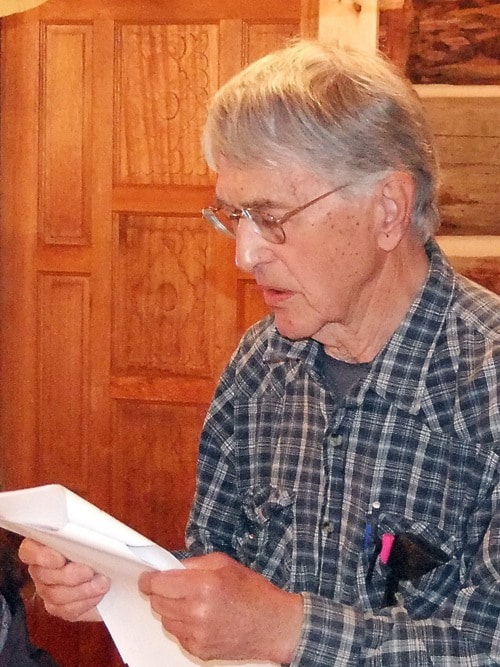Many Upper Clearwater residents are unhappy about Canfor’s plans to log in their area. However, the company has only done preliminary field reconnaissance and has not decided yet how much it will log, if at all, according to a Canfor spokesperson.
Abut 40 people gathered in the Upper Clearwater Hall on Sunday evening, June 17, to hear concerns voiced by members of the Upper Clearwater referral group regarding Canfor’s plans.
Members of the group are George Briggs, Tay Briggs, Tom Dickenson, Ellen Ferguson, Trevor Goward, Erik Milton, Steve Murray, Ryan Papp and Frank Smith.
All but Dickenson were present at Sunday’s meeting.
Papp gave the main presentation on behalf of the referral group.
Canfor’s plans appear to violate a document called the Guiding Principles for the Management of Land and Resources in the Upper Clearwater Valley, Papp said.
That document was developed 13 years ago after three years of dialog between Upper Clearwater residents and Ministry of Forests.
Concerns raised during the meeting followed three main themes: hydrology, viewscapes and mountain caribou.
Canfor’s proposal would involve 14 cutblocks totaling over 1,000 ha on the slopes of the Trophy Mountains.
Large areas of the Trophies were logged in the 1980s, the meeting was told.
During the 1990s there were a series of washouts of culverts and bridges over creeks draining the areas logged.
Cost of repairing the First Canyon washout and replacing the missing culvert with a bridge was about $2 million, the meeting was told. Doing the same at Third Canyon culvert cost $3 million. Other washouts have occurred at Spahats Creek, Grouse Creek and Fage Creek.
Watching normally quiet Fage Creek in flood was one of the most impressive things he’s seen, said George Briggs. Boulders the size of Volkswagens were being moved by the water.
Those at the meeting did not know how much the government had collected in stumpage from the logging in the 1980s but they did not feel it would come close to matching the costs involved in the washouts.
They also were concerned that any new logging might the groundwater and surface water used by Upper Clearwater residents for household uses and irrigation.
Much of the new logging being proposed would be on steeper slopes than were logged in the 1980s, members of the referral group said.
Much of the 1980s logging is still visible today from Highway 5 and Clearwater Valley Road. The new logging would be even more visible, members of the referral group feared.
The recent downturn in the forest economy proved the importance of tourism to Clearwater and the Wells Gray Park area, said Trevor Goward.
Many people come from Europe to enjoy the unspoiled beauty of the park. That enjoyment would be spoiled if they had to drive through clearcuts to get to it, he said.
“We’re the gatekeepers to this and this is a world stage,” said Steve Murray. “If we don’t speak up and do something, they’ll blow through this valley.”
Another concern mentioned was Canfor’s reported plans to log along the west side of the Clearwater River. That area is not included in the Guiding Principles but clearcuts there would be plainly visible from the road to Wells Gray Park.
Pretty well the whole of the Clearwater Valley was burned in 1926, Trevor Goward reminded the meeting.
That meant there hasn’t been much merchantable timber in the valley until now. That is changing as trees mature and sawmill take smaller wood, he said.
The trees in some of the proposed cutblocks are just about mature enough to start providing lichen for mountain caribou to feed on, he said.
If those areas are logged, the clearcuts will attract browsers such as moose, which in turn will attract predators such as wolves, which will attack the caribou, he felt.
What to do about the situation was the subject of much debate.
The Upper Clearwater residents present passed unanimously a motion calling for Canfor to respect the letter and the spirit of the Guiding Principles.
Goward said he planned to work towards a moratorium and invited those present to help him.
